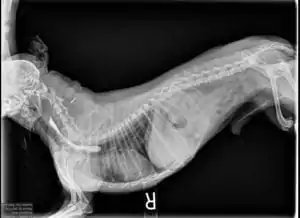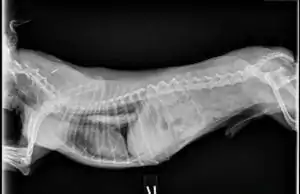What does Megaesophagus mean?
Dogs are extremely food driven. Need to learn a new trick? Treat. Proper elimination? Treat. Mastering call and command? Treat. Did you ever stop and wonder how those treats travel into your dog’s stomach?
The answer is through the esophagus! The esophagus is the tube that links the mouth to the stomach. Megaesophagus occurs when the esophagus becomes dilated (becomes wider) and loses its motility (ability to move food into the stomach).
Are some dog breeds more prone to Megaesophagus?
Megaesophagus is more common in certain dog breeds. These dog breeds are:
- Mini Schnauzers
- German Shepherds
- Great Danes
- Labrador Retrievers
- Shar Peis
- Grey Hounds
- Irish Setters
What are the causes of Megaesophagus?
There are two types of Megaesophagus. They are inherited (born with) or acquired (comes during adulthood). Many diseases can cause acquired megaesophagus. Therefore it is best for your veterinarian to provide the proper diagnostics to further evaluate which condition may be causing it.
By treating the disease causing the Megaesophagus, there is a better chance of minimizing or even resolving it. These diseases are Myasthenia Gravis, stricture, Hypoadrenocorticism (Addison’s disease), esophageal obstruction, Dysautonomia, and Dermatomyositis. Let’s touch upon each of these diseases and how they cause Megaesophagus.
Myasthenia Gravis is the most common cause of Megaesophagus. Myasthenia is defined as muscle weakness. It is a disorder of neuromuscular transmission that has two forms.
- Acquired MG – which is a dysfunction in the immune system that produces antibodies against acetylcholine receptors.
- Congenital MG – an inherited deficiency of these receptors. Acquired MG is more common with clinical signs (a generalized weakness that worsens with exercise, hypersalivation, and regurgitation).
A stricture occurs from previous trauma to the esophagus. This can come from a foreign body, a tumor in the esophagus or chest, or frequent vomiting that scars and narrows the esophagus. This narrowing can restrict food from passing through, causing regurgitation.
Hypoadrenocorticism (Addison’s disease) can also have its hand in causing Megaesophagus. This condition occurs when there is a deficiency of cortisone being released by the adrenal gland. This deficiency results in a disruption of the esophageal muscles, which in turn, weakens them and allows for food to sit and not travel fully into the stomach.
Esophageal obstruction is usually temporary and will resolve once the blockage has been removed.
Dysautonomia is a condition in which there’s a disruption to the autonomous nervous system, including the esophagus.
Dermatomyositis is a condition that affects facial muscles due to a blood vessel defect, causing inflammation. The defect leads to poor oxygen supply and damage to the facial muscles, which leads to megaesophagus.
How is Megaesophagus treated?
Depending on the cause of the Megaesophagus your dog is experiencing will determine the treatment. Megaesophagus itself is not a disease but a condition caused by other diseases. Therefore it is essential for the underlying issues to be treated while also treating the clinical signs of Megaesophagus.
Determining the proper food consistency for your dog is important when treating Megaesophagus. Some dogs do better on liquid diets; others do better on solid diets. Water will need to be supplemented if your dog does better with solid diets. Protein will also have to be supplemented if your dog is underweight. Thickeners can also be added to achieve better consistency.
Elevated feedings will help keep food down and avoid regurgitation. Sitting your dog up after they eat for 10-15 minutes will help with this. There are a few ways to achieve this. There are creative ways to elevate a food bowl. However, if you do not feel like being creative, there is a tool known as the Bailey Chair. The Bailey Chair is designed to keep your dog in an upright position during and after eating.
If aspiration pneumonia is present, it needs to be addressed and treated by your veterinarian before treating the clinical signs of Megaesophagus.
There are oral medications that can help alleviate the signs of Megaesophagus and help improve motility. Medications include:
- Metoclopramide and Cisapride are motility modifiers that help stimulate the gastrointestinal smooth muscle. But, in this case, it is actually used to tighten the lower esophageal sphincter. This allows for digested food to stay inside the stomach and not be regurgitated.
- Antacids are used to protect the lining of the esophagus. Your dog’s stomach not only contains food that may come back up but also some stomach acid as well. Just like it suggests, the acid will burn the lining of the esophagus. Giving your dog antacids will help alleviate pain. Sucralfate should be added on to protect and reduce any inflammation in your pet’s esophagus. The pain may cause reluctance to swallow, which will, in turn, worsen the condition.
- Sildenafil does the opposite of motility modifiers. It opens the sphincter where the esophagus meets the stomach. This gets food out of the esophagus and into the stomach where it belongs.
What is the difference between vomiting and regurgitating?
Vomiting and regurgitating are the same things, right? Wrong! They are actually two different bodily functions that many pet owners confuse as the same. When your pet vomits, they dispel food that has been passed into the stomach. However, with regurgitation, their food is not digested, but just in the esophagus, and due to a defect in gravity, it comes back up. There are also many more warning signs when it comes to vomiting, including drooling, licking, and retching.
What are the two types of Megaesophagus?
As stated before, there are two types of Megaesophagus, acquired and congenital. Congenital is inherited at birth. Puppies with Megaesophagus usually have it from nerve disruption during development or a vascular ring anomaly. A ring anomaly is a band of tissues that are remnants of fetal blood vessels. These vessels cause a ring around the esophagus, causing constriction, which in turn prevents food from passing down into the stomach. They are normally supposed to go away before birth but can be removed surgically if they do not.
Acquired Megaesophagus is caused by any of the diseases listed above. Knowing what caused your dog’s Megaesophagus is important when it comes to treating it. Your veterinarian needs to treat and minimize the megaesophagus to have any luck in potentially resolving it.
What is the prognosis of Megaesophagus?
Megaesophagus prognosis will entirely depend on what is causing it. If it’s congenital, it has a much better prognosis than acquired. Nerve disruption will hopefully improve as your dog gets older.
Unfortunately, with acquired Megaesophagus, the prognosis is usually guarded to poor. Malnutrition and aspiration pneumonia are common occurrences. However, do not be discouraged if you are facing this condition with your pup. There are many ways in which you can work with your veterinarian to limit your pet’s discomfort and avoid other secondary issues that come from it.
Summary
Megaesophagus can be very challenging to treat. Strict owner compliance, dedication, and veterinary intervention all need to be on board for the best outcome. It’s crucial to stay on top of whatever condition is causing Megaesophagus, all the while treating the clinical signs that it is causing the condition. Proper education and intel from your veterinarian will help you to keep your dog comfortable.




